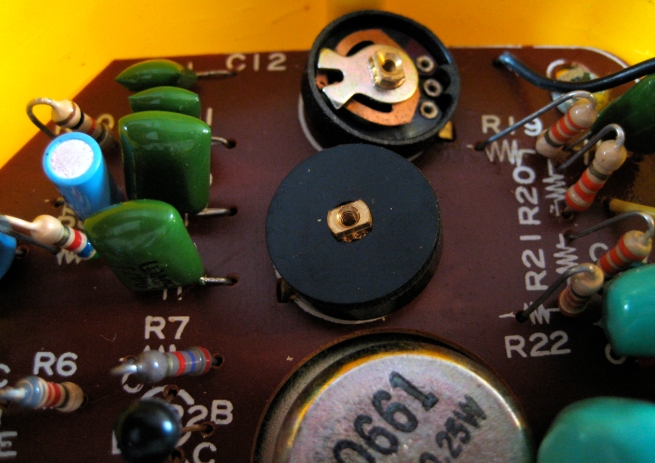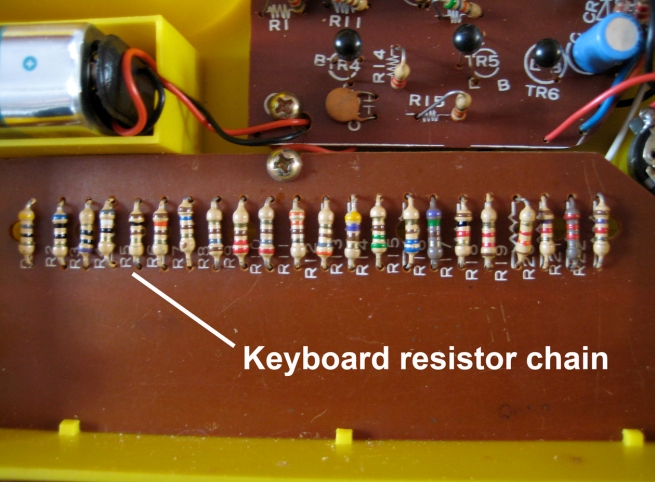There are a number of different instruments called the ‘Melophone’ or ‘Mellophone’. The one on the left in the picture below (by Kc8dis at the English language Wikipedia) is a brass instrument used in marching bands and the one on the right is ‘a cross between a guitar and a harmonium’, according to the Squeezytunes blog (at http://squeezyboy.blogs.com/squeezytunes/2008/02/melophone.html, from which the pictures came).
However, this Melophone which I recently acquired, is clearly a type of Stylophone – and a very stylish type of Stylophone at that!
I had never heard of this Melophone before, and found only a single reference to it on the internet. A glance at the accompanying booklet – which, as you will see below, follows exactly the same style and format as the booklet from a 1960s/70s Stylophone – shows that it was not written by a native English speaker. The company that manufactured it is (according to this website: http://www.pewc.com.tw/eng/) or was (according to this Wikipedia entry: https://en.wikipedia.org/wiki/Taiwan_Mobile) founded in Taiwan in the 1950s and acquired the name ‘Pacific Electric Wire and Cable Company’ on December 30th 1957.
The company would, therefore, have been in place to manufacture the Stylophone after its invention in 1967. It looks as though it may have done so for some years as the picture on the box shows a Melophone with the early Stylophone keyboard with the black non-playing sections; just as the Stylophone was updated with a new keyboard, so it seems was the Melophone.
The flap has a sticker on it showing the colour as yellow, which this one is; but other colours were presumably available.
It is, incidentally, not ‘Colour’, but ‘Color’, which may be an indication of the market it was intended for: Asia or America. There would be no reason why it should not be intended for the UK, as the legend ‘Made in Taiwan’ was commonly seen during that period – except that genuine, British-made Stylophones were available over here, and Dübreq would surely not want to allow or encourage competition.
*
The similarities with the Stylophone – its appearance as well as its booklet – are striking: particularly the distinctively-shaped keyboard with its recess above to hold the stylus.
As can be seen in the above photograph, the size and method of connection to the stylus are also the same as the Stylophone, and a detailed comparison of the yellow Melophone stylus with a black Stylophone stylus, shows that their dimensions are more or less identical:
Nevertheless, there are significant differences – aside, of course, from its handsome ‘Grand Piano’ shape!
First of all, although apparently identical, the Melophone keyboard is longer. With a standard Stylophone on top, this can be clearly seen:
There are 2 extra notes at the bottom end of the keyboard, G and G#, and 1 extra note at the top, F – that is, 23 notes in total, as opposed to the Stylophone’s 20.
You can also see in the above photograph that the Melophone lacks the traditional Power and Vibrato switches at the left-hand end of the keyboard. Instead, the Power On/Off switch is incorporated into a volume control on the top of the Melophone, to the left:
The Vibrato switch is found on the left side, together with a control the standard Stylophone never had – an Octave-change switch!
Using this switch, the range of the Melophone can be extended by another 12 notes, giving the instrument an exceptionally wide range.
Turning the instrument over reveals the battery compartment – like the original Stylophone, the Melophone requires a 9v PP3 battery – and the three screws which need to be undone to access the inside.
The circuit board inside is quite different from the standard Stylophone – and so is the circuit itself: no fewer than 6 transistors can be identified in the following pictures (These are 1 x ED1402A, 3 x ED1402D, 1 x ED1402E and 1 x ED1602E, which are all NPN General Purpose transistors – except the 1602E, which is a PNP):
It has no tuning control like the standard Stylophone; I wonder if the top has been removed from one of the potentiometers in the first internal picture in order to make some pitch adjustment.
*
Comparing the Melophone Booklet with a typical Stylophone booklet of the period, the close similarity is evident:
 Read the Melophone Booklet
Read the Melophone Booklet
Even the two pieces of music at the back of the booklet are the same: ‘Silent Night’ in the key of Bb and ‘The Londonderry Air’ in the key of C, although references to ‘Stylophone’ or ‘Dübreq’ are noticeably absent.
*
One website (http://www.miniorgan.com/lib/view.php?miniorgan=80&view=E&srch=&srch_type=&sortby=&output=14) pictures and describes as ‘another very cheap STYLOPHONE clone’ an obvious copy (which they date to 1976 – the year after production of the original Stylophone ceased, according to the Stylophone Collectors Information Site at http://www.stylophone.ws/index.html). ‘Sounds poor and very poor plastic’, they say; but this Grand Piano Melophone seems like a step up from that, in sound and construction.
Here’s a brief example of the tones made by the Pacific Melophone:
Sufficiently Stylophone-like, I’m sure you’ll agree! The two low notes beneath the Stylophone’s normal lowest note don’t come out too well, though. I’ll have to see if something can be done about that.
Describing a Hong Kong made Stylophone, the Stylophone Collectors Information Site says ‘Problems were experienced by the Dübreq company regarding patent infringments, but licences were apparently also granted, so it is very difficult to categorise this particular model.’ Perhaps the same can be said for the Melophone: it definitely isn’t a Stylophone, but it seems to me reasonably built and with some very close similarities – was it somehow produced under licence, or just a clever copy? If anyone has any further information, please let me know.














